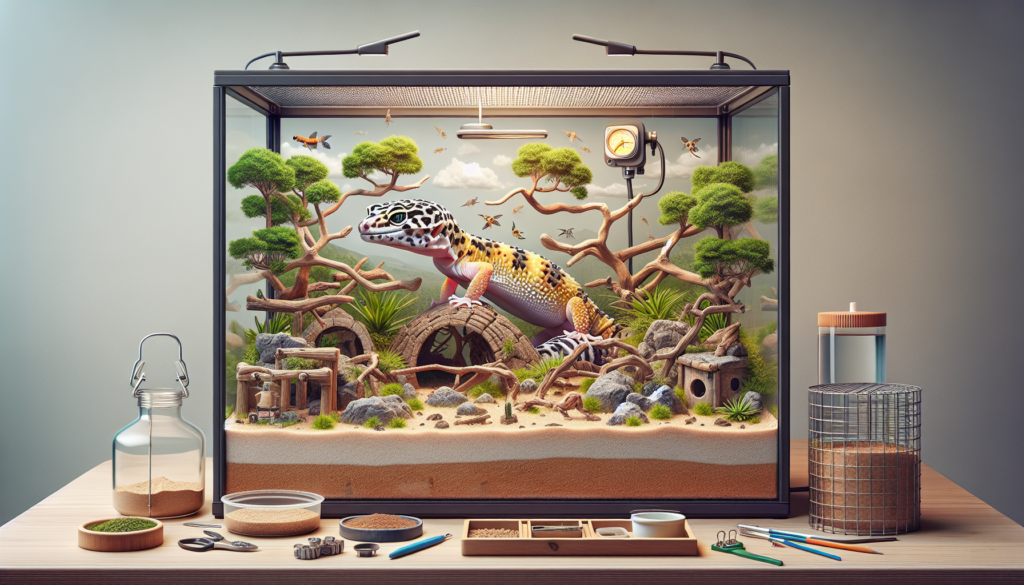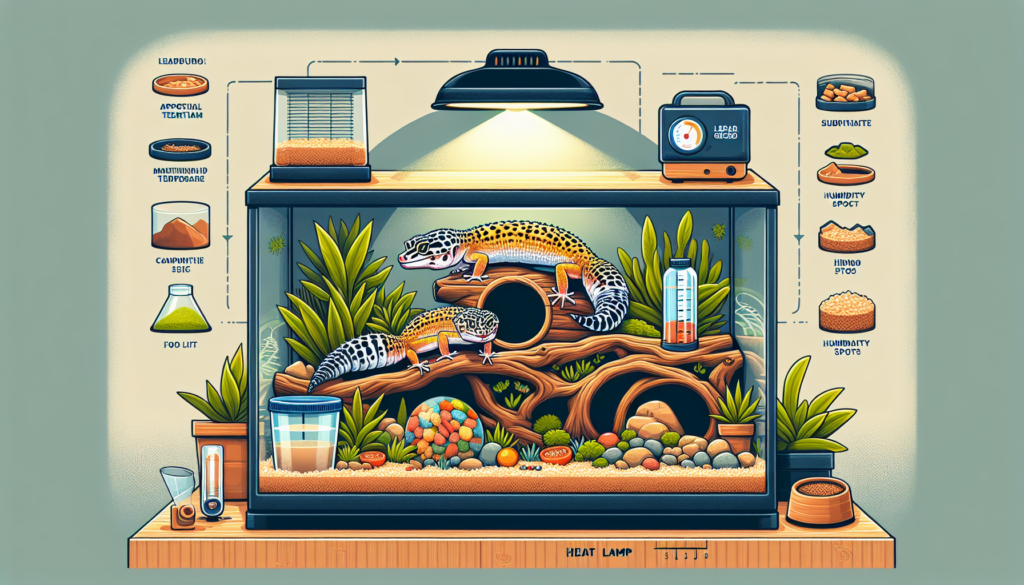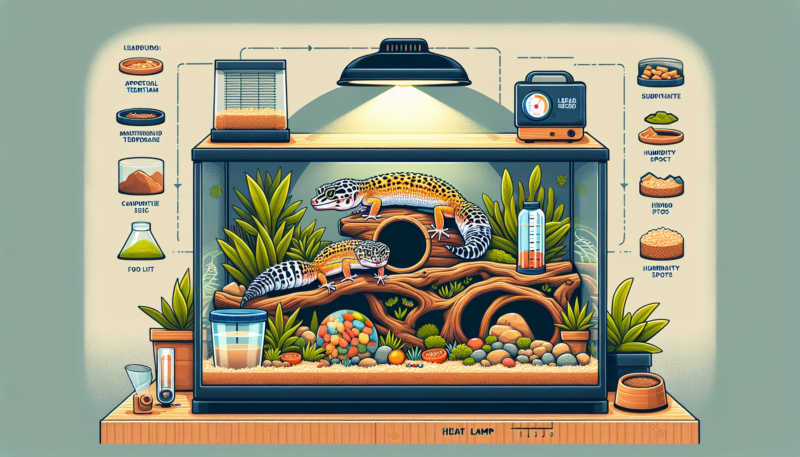Are you a reptile enthusiast, looking to create the perfect habitat for your leopard gecko? Look no further! In this article, we will provide you with all the essential information you need to know about creating a stunning leopard gecko terrarium. From the ideal temperature and lighting conditions to the choice of substrate and decorations, we’ve got you covered. Get ready to transform your reptile’s home into a comfortable and visually appealing sanctuary that resembles their natural habitat. Let’s dive in and discover the secrets to a thriving leopard gecko terrarium!

Leopard Gecko Terrarium
Creating the ideal habitat for your leopard gecko is essential for its overall health and well-being. A well-designed terrarium not only provides a comfortable living space for your gecko but also allows you to observe its fascinating behavior up close. In this article, we will guide you through all the crucial aspects of setting up a leopard gecko terrarium, from choosing the right tank to maintaining the perfect temperature and humidity levels. So let’s dive in and get started!
Choosing the Right Tank
When it comes to selecting a tank for your leopard gecko, you have two main options: glass tanks or plastic enclosures. While both have their advantages, glass tanks are the most common choice due to their durability and better heat retention. Plastic enclosures, on the other hand, are lighter and more suitable for those who frequently travel with their geckos.
Another factor to consider is whether you want to go for an aquarium-style tank or a terrarium. Aquarium tanks are completely enclosed, providing better temperature and humidity control, while terrariums have mesh tops for proper ventilation. The choice depends on your personal preference and the specific needs of your gecko.
When considering tank ventilation, it is crucial to ensure that there is adequate airflow while still maintaining the necessary humidity levels. You can achieve this by having small ventilation holes on the tank walls or using a mesh top for terrariums.
Tank Size and Dimensions
One of the most important factors to consider when selecting a tank for your leopard gecko is the size and dimensions. Leopard geckos require a spacious living environment to explore, thermoregulate, and exhibit natural behaviors.
The minimum tank size for a single adult leopard gecko should be 20 gallons. However, larger tanks are always better as they allow for more freedom of movement. A good rule of thumb is to give your gecko at least 10 gallons of tank space for every inch of its length.
In terms of dimensions, a tank that is 24 inches long, 12 inches wide, and 12 inches tall makes for a suitable starting point. This size provides enough surface area for your gecko to roam and hunt.
Consider whether you want a vertical or horizontal tank layout. Horizontal tanks are generally preferred as they mimic the natural ground-dwelling habitat of leopard geckos. However, vertical tanks can be used if you provide ample climbing opportunities and hiding spots.
External or Internal Tank Heating?
Proper tank heating is crucial for maintaining the overall well-being of your leopard gecko. There are two main options for providing heat: external heating and internal heating.
External heating involves using heat mats or heat tape placed beneath the tank. This method provides a consistent heat source, allowing your gecko to thermoregulate by moving closer or further away from the heat.
Internal heating, on the other hand, utilizes heating bulbs or ceramic heat emitters installed inside the tank. This method creates a basking spot and provides heat from above, mimicking the warmth of the sun.
Both methods have their advantages and disadvantages. External heating is generally more affordable and requires less maintenance, while internal heating provides a more natural sun-like heat source. It is essential to monitor the temperature closely and ensure that it falls within the appropriate range to meet your gecko’s needs.
Spot heating and ambient heating are two approaches to consider when setting up your terrarium. Spot heating involves providing a specific area with a higher temperature, simulating a basking spot for your gecko. Ambient heating, on the other hand, ensures that the overall temperature throughout the terrarium remains within the appropriate range.

Substrate Options
Choosing the right substrate is essential for your leopard gecko’s health and comfort. There are various popular substrate options available, each with its own advantages and disadvantages.
One commonly used substrate is reptile carpet, which is easy to clean and provides a secure footing for your gecko. Another option is paper towel, which is inexpensive and straightforward to replace when soiled. However, both these substrates do not retain moisture well, so additional measures will be required to maintain the necessary humidity levels.
If you prefer a more naturalistic look, you can opt for substrates like coconut fiber, cypress mulch, or reptile bark. These substrates retain moisture better and create a more realistic environment. However, it is essential to be cautious with loose substrates as ingestion can cause impaction in leopard geckos, especially juveniles.
Ultimately, the right substrate choice depends on the specific needs of your leopard gecko, their age, and your preferred aesthetic. It is crucial to research and consider all the pros and cons of each substrate option before making a decision.
Providing Hiding Spots
Hiding spots are crucial for leopard geckos as they provide a sense of security. Creating a variety of hiding spots allows your gecko to choose the preferred hiding spot based on its mood or temperature needs.
There are various types of hides you can consider, such as rock caves, wooden logs, or commercially available reptile hides. It is best to provide at least two hides – one on the warm side of the terrarium and one on the cooler side. This ensures that your gecko has options to regulate its body temperature as needed.
Strategic placement of hides is also essential. Positioning hides near the heat source or under a basking spot allows your gecko to easily access warmth when required. Placing hides in different areas of the tank encourages natural exploration and helps prevent territorial behavior.
Selecting Appropriate Decor
Adding appropriate decor to your leopard gecko terrarium not only enhances its visual appeal but also creates a natural and enriching environment for your gecko. When selecting decor, it is important to prioritize safety and avoid sharp edges or materials that may be toxic to your gecko.
Natural items such as rocks, branches, and fake plants can be used to create climbing opportunities and mimic the gecko’s natural habitat. Ensure that all decor items are securely anchored to prevent collapsing or causing injury to your gecko.
Avoid using items with large gaps or holes, as geckos may inadvertently get stuck. Opt for decor pieces with a smooth surface that can be easily cleaned to maintain a hygienic environment.
Temperature and Humidity Requirements
Maintaining the correct temperature and humidity levels is vital for your leopard gecko’s overall health and well-being. Leopard geckos are native to desert regions, so they require a warm and dry environment.
The ideal temperature range for the terrarium is between 88-92°F (31-33°C) on the warm side and 75-80°F (24-27°C) on the cool side. Creating a temperature gradient within the tank allows your gecko to thermoregulate by moving between different temperature zones.
Monitoring humidity levels is equally important. The humidity in the terrarium should be kept between 20-40%. This can be achieved by misting the tank or providing a moist hide box. However, it is crucial to avoid excessively high humidity levels as it can lead to respiratory issues and skin problems for your gecko.
Incorrect temperature and humidity can have adverse effects on your gecko’s health, including poor digestion, respiratory problems, and shedding difficulties. Regularly check and adjust the temperature and humidity levels in your terrarium to ensure they remain within the appropriate range.
Lighting Needs
While leopard geckos do not require UVB lighting, they do benefit from a proper light cycle. A regular day-night cycle helps establish a natural rhythm for your gecko, promoting physical and mental well-being.
Provide a light source in the terrarium for 10-12 hours a day, mimicking a regular day and night cycle. This can be achieved using a low-wattage white light bulb or a reptile-specific basking light. Avoid using bright or colored lights, as they can disrupt your gecko’s sleep patterns.
It is important to note that leopard geckos are primarily nocturnal, so they require darkness for proper rest. Ensure that the terrarium is in a quiet area during the night to prevent disturbances.
Tank Maintenance and Cleaning
Regular tank maintenance and cleaning are crucial for maintaining a healthy and hygienic environment for your leopard gecko. There are a few key aspects to consider when it comes to tank maintenance.
Spot cleaning should be done daily to remove any feces or uneaten food. This helps prevent bacterial growth and keeps the tank clean. You can use a reptile-safe cleaner or disinfectant to wipe down any contaminated areas.
Periodically, a complete tank cleaning is necessary. This involves removing all decor items, thoroughly cleaning the tank with a reptile-safe disinfectant, and replacing the substrate. It is essential to let the tank dry completely before reintroducing your gecko to prevent any health issues.
When replacing the substrate, make sure to dispose of the old substrate properly and follow any local waste management guidelines. This helps prevent the spread of potential pathogens.
By following a regular tank maintenance routine, you can ensure a clean and healthy environment for your leopard gecko, reducing the risk of bacterial growth and odors.
In conclusion, creating a suitable home for your leopard gecko requires careful consideration of the tank, heating, substrate, hiding spots, decor, temperature, humidity, lighting, and maintenance. By providing an optimal terrarium environment, you are setting the stage for your leopard gecko to thrive and lead a happy life. Remember to observe your gecko’s behavior closely and make any necessary adjustments to ensure its comfort and well-being. Happy terrarium setup!
